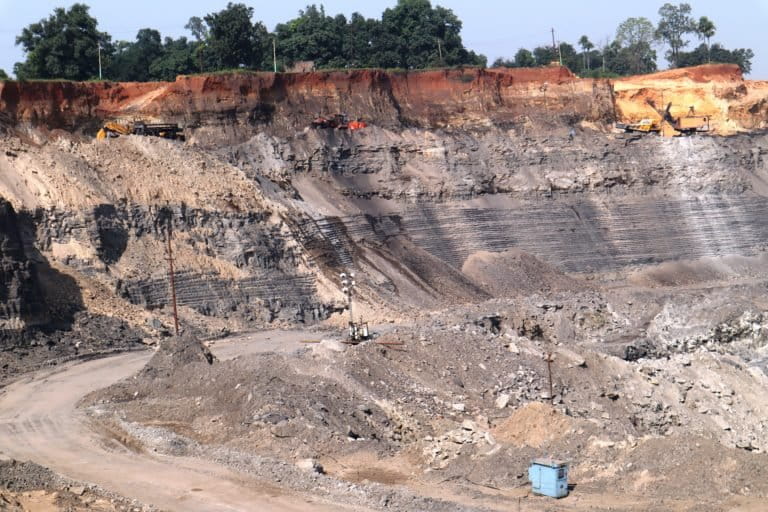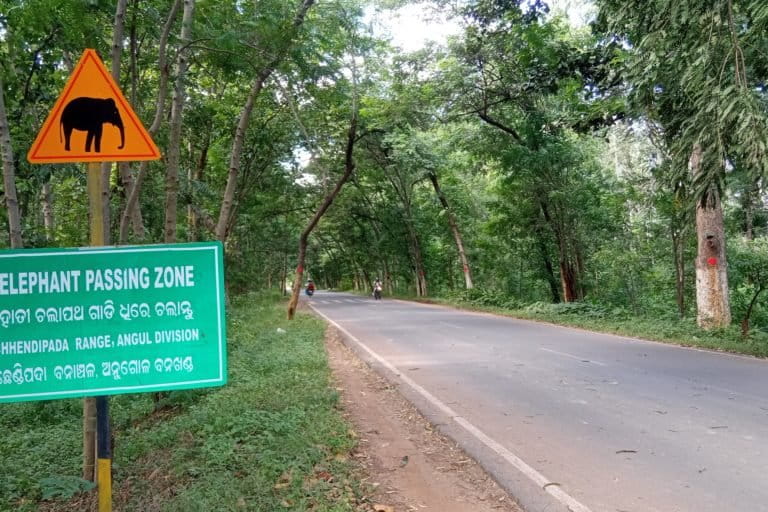- Talcher in the Angul district of Odisha hosts the largest repository of power grade coal in India, which helps in catering to the power needs of the state and some of the western and southern states of India.
- The coal industry at Angul provides thousands of direct and indirect jobs, besides contributing to the state revenue. This makes decarbonising while ensuring a ‘just transition’, a difficult task.
- A recent study on the just transition challenges at Angul claimed that the coal production in the district is likely to peak in the next 10 years and then sink post 2040. Energy experts believe that this provides the opportunity to ensure a just transition for coal workers.
Talcher in the Angul district of Odisha is merely 123 kilometres away from the state capital Bhubaneswar and is well connected with two long stretched roads — one is a national highway, and another is a state highway. The residents of this small city are well-accustomed with the sight of an old conveyor belt carrying coal and running parallel to the road leading to Talcher. Thousands of coal-carrying trucks smeared with thick layers of coal, frequent this road. This exposes people to the risk of air pollution.
Talcher is India’s largest coalfield reserve for power grade coal. Some interior villages near the coal mines in Talcher, such as Rakash, often face the brunt of air pollution too. A railway loading station near Talcher where coal is dumped for rail transportation, often sees the release of heavy dust, as loaded trucks pass. However, the residents of this region are used to the conditions and many mining workers living in these areas have nothing to say against the mining operations here. Infact, their livelihood depends on coal.
Livelihoods tied to coal mines
For a number of coal mine workers and the local population, the coal mines here are largely responsible for their livelihood. Estimates claim that the district of Angul alone has a total of 1,68,000 workers directly or indirectly dependent on coal mining for their livelihood. These could be coal mine workers, workers from coal thermal power plants, coal washeries and other industries dependent on coal, such as steel and aluminium.
“Our village (Rajhartang) is around 10 kilometres away from Angul. It has a population of around 600 and more than half of the population here, is directly or indirectly linked to coal mines and associated industries. Some work in mines, some in the nearby steel and aluminium industries and many are also involved as truck drivers involved in the transportation of coal, out of Angul. Coal mining here has taken care of the livelihood of several of the households in our village and many other villages in the district,” said Debabrata Swain, a resident of Rajhartang , Angul.
Sarang Deuri from Chotihati, a village that lies close to the railway station, paints the same picture about coal mining being the major occupation. He told Mongabay-India, “The young people in their neighbourhood work as labourers in the coal industries. In the whole Talcher area, you will see either the coal mine workers and labourers involved in many contractual and informal workers or truck drivers. The whole local livelihood revolves around coal and coal-dependent industries.”

Angul is important in Odisha’s map, because of its rich coal. It is India’s third largest coal producing district. The district has a total of nine operational mines, most of which are open cast mines with just one exception. Odisha is an energy surplus state, where supply is more than demand and that is why it supplies thermal energy to other southern and western states. Four thermal power plants are situated in the district while it also hosts an integrated steel plant, a planned aluminium park, an aluminium smelter, a fertilizer plant and many other industries dependent directly or indirectly on coal.
A golden opportunity to plan a just transition
The story of Angul, however, is not like the other coal mining areas in India. Mahanadi Coalfields Limited (MCL), a subsidiary of Coal India Limited (CIL) which operates all the coal mines in Angul district is one of the most profitable units compared to the subsidiaries in other states, where coal mining revenues are either stagnant or are declining.
While the district has now eight operational coal mines, more coal mines are all set to be added into the district with the allocation of new coal blocks in Chhendipada and other regions. Coal mines are expanding in the state and coal production will increase in the days to come. In 2020-21, Angul reported a total of 96.7 million metric tonnes (MMT) of coal production and it is estimated that in the next 10 years the production will touch 308.8MMT if all proposed coal mines come into operation.
A New Delhi-based think tank– iForest recently conducted a survey on the just transition challenge in Angul. ‘Just Transition’ refers to energy transition in any area from fossil fuel-based energy like coal to clean energy, by ensuring justice to the communities involved in livelihoods that produce polluting sources of energy. The study that followed the survey stated that the coal production in Angul is likely to peak in next 10 years while the total number of workers engaged in coal mining and coal-dependent industries are likely to double in the same time period. However, it claimed that a majority of the workers involved in the works in coal bearing areas are informal workers.
According to the report, coal production in Angul would start declining after 2040, and it would be phased out by 2070, and several old and aging thermal power stations in the district will stop functioning from this decade. As the technology in renewable energy improves in the coming days, the transition from coal-based power to renewable energy sources like solar will become viable, leading to a shift of energy sources from the polluting fossil fuel-based energy like coal to clean sources of energy which are set to become cheaper.
Researchers from iForest who worked on this report, also told Mongabay-India that Angul portrays a different scenario unlike other coal belts of India. “In several coal belts in Jharkhand and Chattisgarh we saw the closing down of coal mines and the threat of joblessness in near future which is not the case of coal mines of Angul. As the report predicted peaking of coal production in next 10 years, the threat of joblessness due to energy transition does not arise in the immediate future here. So, the district and the state now have got the golden opportunity to plan the transition judiciously through adequate policies and examples,” Srestha Banerjee, co-author of the report, told Mongabay-India.
She also added, “Right now what the policymakers can do here is make use of the cheap coal power available here to support the establishment of green manufacturing sectors to pave the way for a smooth energy transition to make the future ready for green jobs. This could be done by using coal gasification methods to produce Green Hydrogen or using coal to give impetus to the energy efficiency sector manufacturing like in producing electric vehicles, solar panels, batteries for storage and others.”
The report also batted for making timely policies, programmes and legislations to ensure a smooth energy transition in the district. It highlighted Odisha’s Climate Action Plan’s provision to boost renewable energy and stated that it needs to include the provision of planning for just transition in Angul and other coal belts of the state.

‘Decarbonising efforts have begun in Angul’
The district administration however claimed that work to decarbonise the coal belt has already started with the planned use of renewables in the region. Siddharth Swain, Angul District Collector told Mongabay-India, “We have started working for the complete solarisation of Talcher in the Angul district. We have planned to use the land abandoned after coal mining, to install a solar grid on 80 acres of land. Such land often becomes unviable for other works, so we plan to utilise such lands for this. We have undertaken surveys of public areas and public buildings in the first phase and are now all set to survey other areas. Soon the city will see a clean source of energy and shun fossil fuels. We also plan to make use of the local community in the best possible way to handle the clean energy project.”
When asked about the steps taken for a just energy transition he said, “We have started a survey on the issue and after analysing the results we will make plans accordingly. Meanwhile, with the help of international organisations like UNEP we have also started skill upgradation of the workers and local communities.”
Available funds and planning ahead
Energy experts working in the area state that around one lakh people in the Angul district are directly or indirectly involved in coal mining and related activities and their livelihoods could get threatened if the mines are closed without proper resettlement and welfare plans.
“Due to expansion of coal mines in Angul several people lost their homes and their farm lands. Many farmers lost their farming-based livelihoods. Some took up jobs in the mining sector. In case renewable energy is the future and coal mines are closed in future, it is unlikely that the clean energy sector can accommodate the large number of people, whose livelihood now depend on coal and coal-based activities. The government needs to not only train them in new skills but also need to involve them in agricultural related jobs and avenues in which many of the residents of the area were skilled,” Angul-based Swapna Sarangi, General Manager (Programme) of Foundation for Ecological Security told Mongabay-India.
Experts claimed that finances in energy transition in coal bearing regions of Odisha would not be a problem due to the availability of the District Mineral Foundation (DMF) funds, coal cess and other coal revenues. According to the iForest study, through DMF and coal cess alone the district would see fund availability of up to Rs. 1.9 trillion (USD 24 billion) over the next 20 years.
According to a recent information shared by the Ministry of Coal in Lok Sabha, the Angul district saw collection of 2149.81 crore rupees as DMF Funds by the end of March 2022. In terms of planning and budgeting, Odisha is also one of the few states which has separate annual climate budgets, besides having statements on climate financing and having a State Climate Action Plan.
The Odisha State Climate Change Action Plan for the period of 2021-30 does not specifically mention ‘Just Transition’ but it talks about boosting solar energy in the state and undertaking sustainable mining. The document claimed that, to meet India’s global commitments made at the UN climate conference at COP26 last year, the state would work towards maximising solar power generation in the state, undertake the development of green spaces and green parks in urban areas, and take measures to develop methodologies to measure, monitor and verify the amount of carbon sequestration by plantation programmes.

According to the latest Economic Survey of Odisha, the state hosts 24 percent of India’s coal reserves. It is also the largest steel and stainless-steel producer of the country, which is largely dependent on coal. The same government report claimed that on record, the coal industry in the whole of Odisha employs 21,670 workers directly. Besides Angul, coal mining is the biggest occupation in the Sundergarh and Sambalpur districts of Odisha, which also have just transition challenges to tackle.
Banner Image: A railway loading centre at Talcher where coal mined in Talcher are loaded into the trains. Photo by Manish Kumar/ Mongabay.
